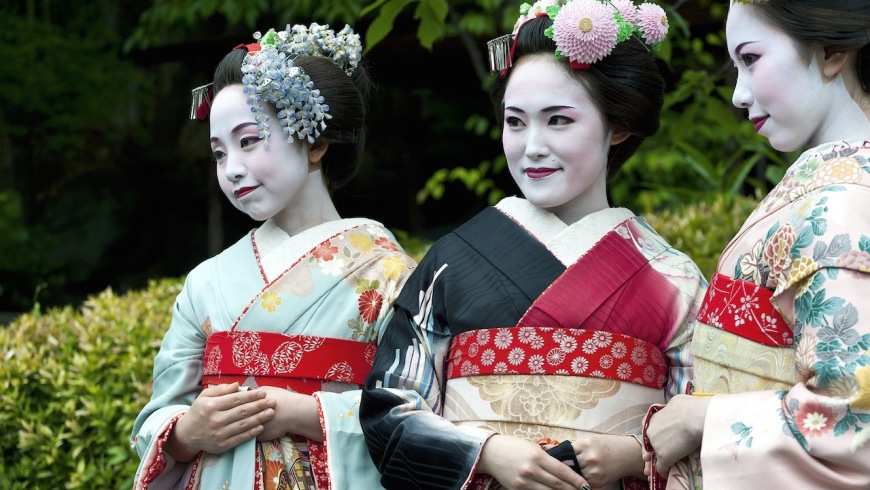
Before the Commodore Matthew Perry, in 1853, anchored his nine ships in the bay of Tokyo, defying the edict isolationist of the Togugawa dynasty that prevailed since two centuries in Japan, the country of the Rising Sun had remained strictly closed in on itself. No one was allowed to contaminate the islands of the archipelago with products and habits. Stories were told about Japan. There was talk of geishas and pleasure districts, of buildings built of wood and rice paper, incomprehensible ceremonies and rituals, of unbeatable samurai, gardens of stones, colossal statues of Buddah. The protophotographers, who exercised their art mainly in Yokohama, were ready and willing to represent that unknown world and they also idealized it, producing images of idyllic landscapes and everyday situations that had been cleverly staged in the studio. Even more, they refined a technique of watercoloring black and white prints taken with great cameras, which amazed for the sublime achievements in the nuance of tone and the perfection of the contours. Among these an Italian excelled, Felice Beato, of who’s life little is known, the brother of another photographer that Barnum readers already know (v. https://www.barnum-review.com/portfolio/vintage/). The photo albums produced in the studios of Yokohama were made with valuable decorated lacquer covers and were sold at the beginning of the 1900s at a high price, in the department stores of the time in Europe, from Liberty’s in London, to Lafayette’s in Paris… Furthermore, mystery enveloped the country’s image and even today, perhaps because of the natural reluctance of its inhabitants, the image of Japan is not exactly clear. Its products, always of excellent quality, have invaded the world and weakened the penetration into the markets of European industries with established traditions, but those that have not set foot on that land, which often trembles, find it hard to visualize the appearance of everyday life in a Japanese city. BARNUM has therefore decided to publish a series of photographic reports made recently in different locations. The second is dedicated to:
Kyoto, a million and a half inhabitants, situated on the island of Honshu 460 km west of Tokyo, was the second historic capital of Japan from 794 to1868. Spared by the bombings of World War II, it has the reputation of a relic of Japanese culture and benefits of the recognition of a UNESCO protected site. It houses more than a thousand temples, in many of which there are well looked after Zen gardens, places of meditation and sublimation of minimalist aesthetics. Surrounded by hills, it is crossed by the river Kano that separates the commercial district from the ancient center of Gion. The most impressive temples, almost twins, are the ones of Homgan-ji, the Nishi and Higashi, not far from the train station, whose shiny tatami are frequented by millions of faithful of the Jodo-Shinshu sect. Popular, also, is the temple of Sanjusangendo that hosts, under a wooden structure, more than one hundred meters long and is renewed regularly since 1164, a thousand and one statues of the goddess Kannon, all natural height, in gilded wood, protected by colossal guardians. Nijo Castle is the symbol of the power of the shogun Tokugawa Iemitsu (1543-1616) and the Ninomaru complex, consisting of the reception rooms, well represents the magnificence of the court. Another famous institution is the Kiyomizu-dera, in the hills, where, from the porch you can admire the whole city and the source from which pure waters that are said to have miraculous effects gush. The Daitoku-ji temple prospered under the patronage of Oda Nobunaga and Hideyoschi, in the second half of the sixteenth century, as the venue for refined tea ceremonies (v. https://www.barnum-review.com/portfolio/tea-cerimony-kyoto/). Very well known is its rock garden, the Daisen-In, considered the most sublime example of gardens of this kind. Tourists call the Kinkaku-ji temple the Golden Pavilion, former home of the shogun Ashikaga Yoshimitzu (1358-1408). Destroyed by fire in 1950, it has been masterfully rebuilt and covered again with gold leaf. With a metropolitan train one can reach, in less than half an hour, the Fushimi shrine, dedicated to Inari, the god of rice and sakè. Feature of the temple is the avenue that precedes it and is a succession of torii (portals) in wood painted red and in many cases sponsored by wealthy businessmen. Kyoto is also considered the city with the best schools for geischa that here prefer to be called geiko and for maiko, the young apprentices who are a unique phenomenon of Kyoto. The enclaves where the most popular geisha live, complete with a government plaque on the door that certifies the qualification, are Gion-kobu and Pontocho.
It is unnecessary to add that Kyoto is a prime level tourist destination and it is curious to note that many girls and young women wear, when visiting the city, kimonos, or rent one, and love to have their hair dressed according to the ancient traditions.